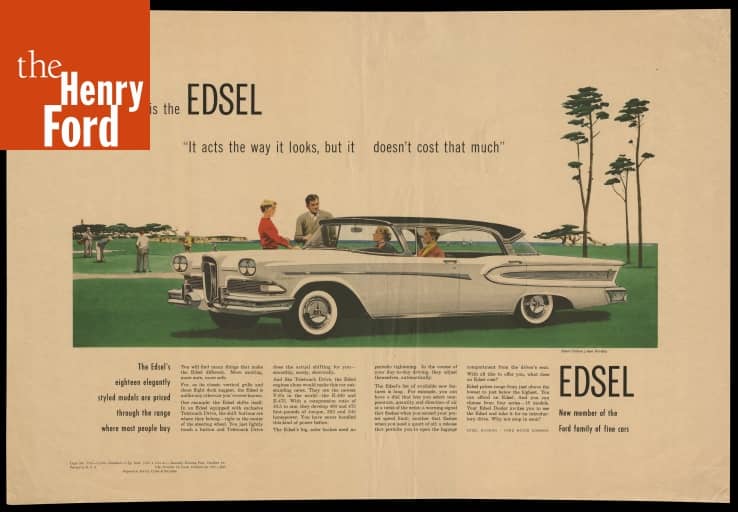At the time of its release in 1957, the Edsel was derided as the ugliest hunk of rolling metal that Detroit had ever produced and since then, the infamous car has become a cliché for brand failure. Everything from New Coke to Google Glass has been compared to Ford’s debacle that was the Edsel.
But was it really that bad of a car?
The short answer is yes, but for reasons other than the “horse collar” grill.
Edsel was developed during an interesting time in automotive history. The Great Depression had thinned the herd, so to speak, and most of the small car manufacturers had left the scene, leaving only the Big Three (General Motors, Ford and Chrysler) along with AMC.
With the Depression and World War II over, consumers were eager to have the newest and freshest of automobiles sitting in the suburban driveway.
The corporate strategy for all of the Big Three automakers was to create brands that acted as a “staircase” for the different price fields. The idea was to create loyalty to the overall brand by offering a model for every consumer.
A customer might start with a Chevrolet, then move up to a Pontiac or Oldsmobile and once they had achieved financial success, they could wow the Jones family next door by purchasing a shiny new Cadillac.
The “Whiz Kids” at Ford determined that the company had a gap, so to speak, in the price range between the low-priced Fords and mid-level Mercury brand.
According to Road and Track magazine, Ford wanted to create the perfect car for the up-and-coming professional; however, no one in upper management could articulate exactly what that car should be.
Even settling on a name was a years-long, arduous process. According to the Poetry Foundation, Ford even went as far as to ask the Pulitzer Prize-winning poet Marianne Moore to come up with suggestions.
Moore came up with outrageous and even silly names such as the Utopian Turtletop, Mongoose Civique and Pluma Piluma.
The Experimental Car or E-Car team waited until Henry Ford II was out of town to propose the name Edsel to the company’s board, which infuriated Ford who was said to exclaim, “I do not want my fathers name spinning around on hubcaps!”
At the same time that Chrysler was developing the “Forward Look” design under Virgil Exner, the Ford team, headed up by Roy Brown Jr., argued and fussed over every tiny design detail. The Edsel became a car designed by committee, sealing its doom long before the car ever went to market.
Not only could the executives, engineers and designers not get along, the workers at Ford’s Oakville assembly plant did not want anything to do with the vehicle.
Rather than have a dedicated Edsel assembly plant, Ford chose to shoehorn the new car into Oakville, so the assembly line would have Mercury Monarchs and Meteors followed by Edsel Corsairs and Rangers. The workmen would have to change out their tools every time an Edsel came down the line.
To say the new vehicles suffered from poor build quality would be an understatement.
The result was seams that didn’t fit right, trunks that leaked and faulty welds, according to Hagerty. It was said that some workers intentionally sabotaged the cars and would leave bolts inside the door panels that would rattle around when the car was driven.
Ford dealers were also outraged that many of the vehicles were delivered unfinished with the parts left in the trunk for the dealers to install.

The multi-million dollar ad campaign focused on the car’s gimmicks, such as the push-button transmission selector placed in the center of the steering wheel and even that became a fiasco because, out of habit, drivers would push the center of the wheel to operate the horn and end up damaging the transmission.
Not only were consumers turned off by the ugly front-end design, but they were perplexed at the pricing structure.
The intent was to place Edsel’s pricing between Ford and Mercury, but it didn’t exactly work out that way. Over the span of 18 different models, the pricing overlapped, leaving consumers wondering why they should buy an Edsel when they could go with a high-end Ford or a low-end Mercury.
All in all, with the Edsel, if it could go wrong, it did. It did not help that a recession in the economy occurred right at the time of the release of the brand in 1958 and pushed more buyers to what was tried and true. Ford finally threw in the towel and shuttered the brand after the 1960 model year.
The Edsel has made a resurgence with car enthusiasts lately, but Jamal Dickinson, of Augusta, warns that Edsels are not for novices or those on a budget.
Dickinson and his father bought a 1959 Edsel four-door Corsair Hardtop to work on as a hobby, but found the car simply too expensive to maintain.
“The car stayed parked more than it drove. Keeping it running was expensive, the parts are rare and cost an arm and a leg,” Dickinson said.
Scott Hudson is the Senior Investigative Reporter and Editorial Page Editor for The Augusta Press. Reach him at scott@theaugustapress.com











